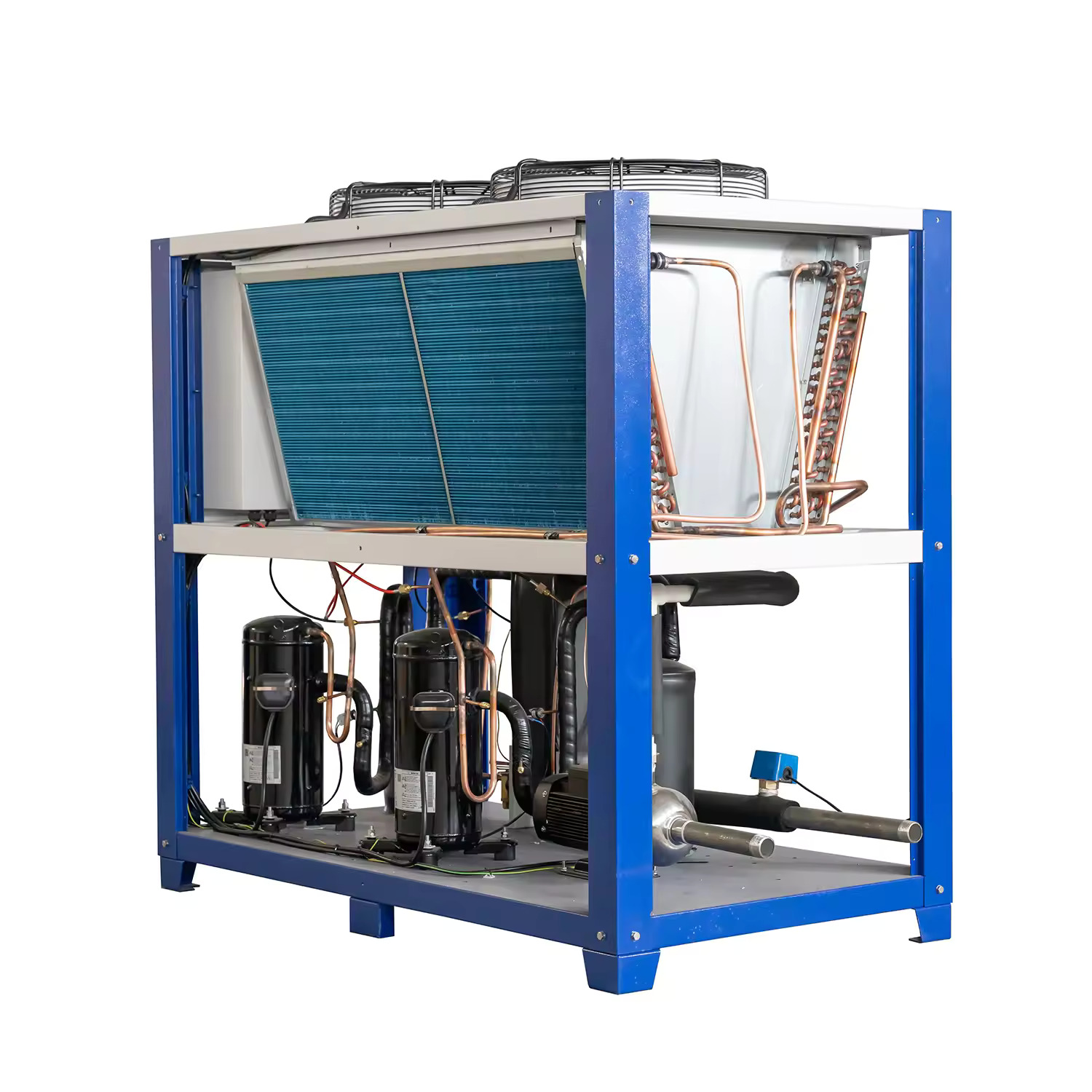Introduction
Food-grade chillers are specialized cooling systems designed to meet the stringent hygiene and safety requirements of the food and beverage industry. By maintaining precise temperature control, these chillers ensure the quality, freshness, and safety of perishable products during various stages of processing, storage, and transportation. Constructed from materials that resist bacterial growth and withstand harsh conditions, food-grade chillers are essential for applications ranging from dairy production and meat processing to breweries and confectionery. With features like energy efficiency, corrosion resistance, and IoT integration, these chillers play a vital role in enhancing operational efficiency and meeting regulatory standards in food manufacturing.
Key Features
- Sanitary Design
Food-grade chillers are constructed with high-grade stainless steel (typically SS 304 or SS 316), known for its durability and resistance to corrosion, which makes it suitable for environments that demand stringent hygiene. The smooth, non-porous surfaces prevent the accumulation of residues or bacteria, while the rounded edges and absence of crevices minimize cleaning time and reduce the risk of cross-contamination. Additionally, food-safe refrigerants (such as HFO or ammonia) are used to ensure safety in cooling operations, while hygienic tubing ensures the system meets industry standards like FDA and HACCP compliance. - Temperature Accuracy
Food-grade chillers integrate advanced temperature control technologies, including PID controllers, digital thermostats, and sensors, to maintain precise cooling. These systems can hold temperatures within tight tolerances, such as ±0.5°C, which is critical for sensitive processes like fermentation in yogurt production or freezing seafood without compromising quality. Additionally, programmable settings allow operators to customize the temperature profiles for different applications, ensuring that each product receives the exact cooling conditions it needs. - Corrosion Resistance
Food-grade chillers are often exposed to harsh substances, such as acidic fruits, saline brines, or carbonated beverages. To address these challenges, they are constructed with corrosion-resistant materials like titanium or stainless steel alloys. Special coatings, such as epoxy or ceramic layers, can further enhance durability by shielding components from chemical attacks. These materials extend the life of the chiller and ensure consistent performance, even in aggressive environments. - Energy Efficiency
Modern food-grade chillers employ variable-speed compressors and energy recovery systems to optimize energy consumption. These systems adjust cooling power based on real-time demand, ensuring that energy is not wasted during low-load periods. Eco-friendly refrigerants, such as R290 or CO2, reduce the environmental footprint while maintaining high performance. Intelligent controls, often equipped with AI-driven algorithms, monitor and regulate operations to further reduce power usage and operating costs. - Compact and Modular Designs
The modular design of food-grade chillers allows manufacturers to scale operations easily by adding or removing units based on production needs. Compact models are particularly beneficial for small-scale facilities or those with space constraints, fitting seamlessly into tight spaces without sacrificing performance. Additionally, portable options with caster wheels or quick-connect fittings make it easier to relocate or reconfigure the equipment based on production line requirements.
Additional Features
- Low Noise Operation
Chillers designed for minimal noise output use advanced acoustic dampening and low-vibration components, making them suitable for applications like bakeries or breweries, where excessive noise could disrupt workers or customers. - Redundant Cooling Systems
Redundancy ensures that a backup cooling circuit or unit takes over in case of a failure. This is critical for industries with continuous operations, such as dairy plants, where even brief downtime could result in spoiled products and significant financial loss. - Customizable Options
Manufacturers offer tailored solutions, such as chillers with specific cooling capacities, custom piping materials, or integrated heat exchangers, to cater to niche applications like wine fermentation or chocolate cooling. - Automation and IoT Integration
IoT-enabled chillers offer real-time monitoring and data analysis, alerting operators about maintenance needs or performance issues. This predictive maintenance reduces downtime and ensures smooth operation. Integration with factory automation systems also allows seamless synchronization with other equipment.
Applications
- Dairy Industry
Chilling milk immediately post-milking helps retain its freshness and prevent bacterial growth. Food-grade chillers are also essential in yogurt fermentation, where they maintain specific temperatures over extended periods. Cheese production benefits from chillers during both the coagulation and storage phases to achieve consistent quality and texture. - Meat Processing
Rapid cooling is necessary after slaughter to bring meat to a safe storage temperature, inhibiting microbial growth. Blast chillers, a subset of food-grade chillers, can cool large quantities of meat in a short time, preserving texture and nutritional value for packaged and fresh meats. - Breweries
Wort cooling is one of the most temperature-sensitive steps in beer production. Food-grade chillers quickly lower the wort’s temperature to fermentation levels (around 10°C-15°C for lagers) without compromising its flavor profile. Additionally, chillers maintain the temperature of fermentation tanks to ensure yeast activity remains optimal. - Chocolate and Confectionery
The chocolate tempering process relies on precise cooling to ensure a glossy finish and a smooth texture. Chillers maintain consistent temperatures during cooling tunnels, preventing bloom (whitish discoloration) and ensuring a high-quality product. - Seafood Processing
Freshly caught seafood often undergoes rapid chilling in brine tanks or ice-making systems powered by food-grade chillers. This quick cooling preserves the seafood’s texture and flavor while extending its shelf life during transportation or storage.
Conclusion
Food-grade chillers are indispensable for maintaining product quality, safety, and consistency in the food and beverage industry. Their specialized designs, precision temperature controls, and robust construction ensure compliance with hygiene standards while meeting the diverse cooling needs of applications such as dairy, meat processing, breweries, and confectionery. By integrating advanced features like energy efficiency and IoT connectivity, these chillers not only enhance operational efficiency but also align with sustainability and modern automation trends. Investing in food-grade chillers is a strategic decision for food manufacturers aiming to deliver superior products while optimizing processes and adhering to industry regulations.

